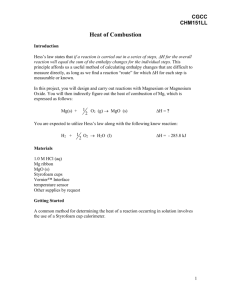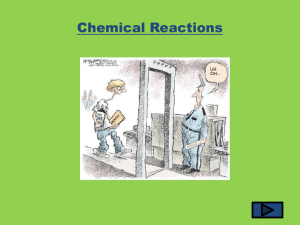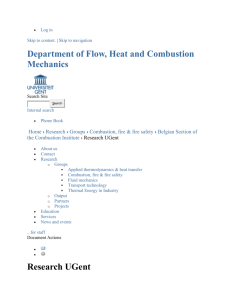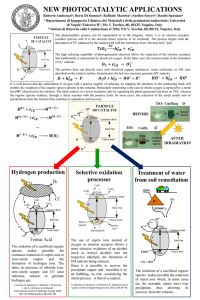Microsoft Word
advertisement
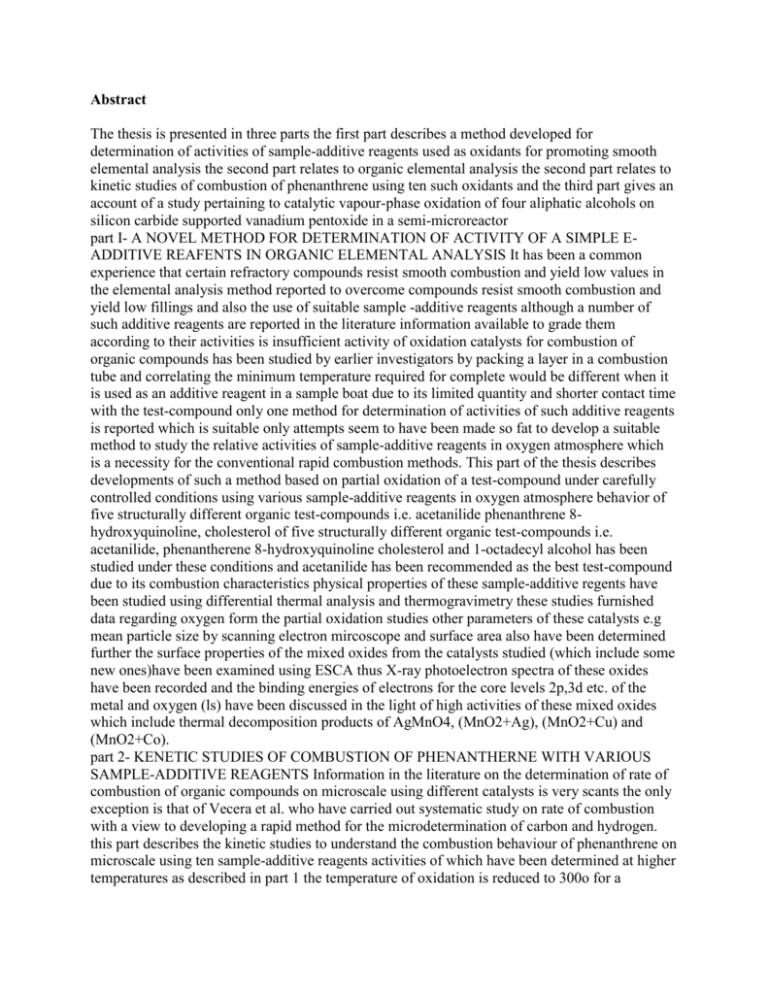
Abstract The thesis is presented in three parts the first part describes a method developed for determination of activities of sample-additive reagents used as oxidants for promoting smooth elemental analysis the second part relates to organic elemental analysis the second part relates to kinetic studies of combustion of phenanthrene using ten such oxidants and the third part gives an account of a study pertaining to catalytic vapour-phase oxidation of four aliphatic alcohols on silicon carbide supported vanadium pentoxide in a semi-microreactor part I- A NOVEL METHOD FOR DETERMINATION OF ACTIVITY OF A SIMPLE EADDITIVE REAFENTS IN ORGANIC ELEMENTAL ANALYSIS It has been a common experience that certain refractory compounds resist smooth combustion and yield low values in the elemental analysis method reported to overcome compounds resist smooth combustion and yield low fillings and also the use of suitable sample -additive reagents although a number of such additive reagents are reported in the literature information available to grade them according to their activities is insufficient activity of oxidation catalysts for combustion of organic compounds has been studied by earlier investigators by packing a layer in a combustion tube and correlating the minimum temperature required for complete would be different when it is used as an additive reagent in a sample boat due to its limited quantity and shorter contact time with the test-compound only one method for determination of activities of such additive reagents is reported which is suitable only attempts seem to have been made so fat to develop a suitable method to study the relative activities of sample-additive reagents in oxygen atmosphere which is a necessity for the conventional rapid combustion methods. This part of the thesis describes developments of such a method based on partial oxidation of a test-compound under carefully controlled conditions using various sample-additive reagents in oxygen atmosphere behavior of five structurally different organic test-compounds i.e. acetanilide phenanthrene 8hydroxyquinoline, cholesterol of five structurally different organic test-compounds i.e. acetanilide, phenantherene 8-hydroxyquinoline cholesterol and 1-octadecyl alcohol has been studied under these conditions and acetanilide has been recommended as the best test-compound due to its combustion characteristics physical properties of these sample-additive regents have been studied using differential thermal analysis and thermogravimetry these studies furnished data regarding oxygen form the partial oxidation studies other parameters of these catalysts e.g mean particle size by scanning electron mircoscope and surface area also have been determined further the surface properties of the mixed oxides from the catalysts studied (which include some new ones)have been examined using ESCA thus X-ray photoelectron spectra of these oxides have been recorded and the binding energies of electrons for the core levels 2p,3d etc. of the metal and oxygen (ls) have been discussed in the light of high activities of these mixed oxides which include thermal decomposition products of AgMnO4, (MnO2+Ag), (MnO2+Cu) and (MnO2+Co). part 2- KENETIC STUDIES OF COMBUSTION OF PHENANTHERNE WITH VARIOUS SAMPLE-ADDITIVE REAGENTS Information in the literature on the determination of rate of combustion of organic compounds on microscale using different catalysts is very scants the only exception is that of Vecera et al. who have carried out systematic study on rate of combustion with a view to developing a rapid method for the microdetermination of carbon and hydrogen. this part describes the kinetic studies to understand the combustion behaviour of phenanthrene on microscale using ten sample-additive reagents activities of which have been determined at higher temperatures as described in part 1 the temperature of oxidation is reduced to 300o for a conveniently measureable rate of combustion the rate has been studied by estimating at fixed time-intervals the carbon dioxide obtained after combustion of the oxidation products formed the rate constants equations for the best straight lines for the curves showing relationship of the sample combusted with time have been found out by the method of least squares activities of the catalysts showed a general correlation with intercepts of the slopes of the equations could not give any guiding information regarding such a correlation the control of combustion of an organic compound on a micrpscale using a sample-additive reagents thus seemed to be extremely difficult for desired accurate kinetic studies. part 3 CATALYTIC VAPOUR-PHASE OXIDATION OF SOME ALIPHATIC ALCOHOLS ON CANADIUM PENTOXIDE IN A SEMIMECROREACTOR Aldehydes from a very important class of organic compounds as they are among the most reactive compounds although a number of methods are available for their preparation on industrial scale the well known oxo processes (by formylation of a suitable olefin ) dehydrogenation of alcohols over copper chromite catalyst and oxidation of alochols over silver catalyst seem to be the major processes the oxidation of lower aliphatic alcohols has a special industrial significance for these aldehydes are important intermediates catalytic vapour-phase oxidation of ethyl alcohol to acetaldehyde on industrial scale using silver catalyst is a case in point although catalytic vapour-phase oxidation is a domain of chemical engineers a study of catalytic vapour-phase oxidation of alcohols to obtain the respective aldehydes using silican carbide supported vanadium pentoxide in a semimicro reactor was undertaken to assess the possibility of getting useful information for its further scaling up thus this part of the thesis presents some aliphatic alcohols, l-butanol,lhexanol,l-octanol and l-decanol,which has been carried out on V2O5/sic catalyst (~10% w/w) at 250o, 300o and 350o in a specially designed semi-mireo reactor. the oxidation products have been studied using gas chromatography. In addition to the expected aldehydes and small quantities of acids some unidentified product was obtained in each case the nature of which was decided using GC-MS. it was observed that the conversion of the oxidized alcohol to aldehyde per pass was excellent (~90%) in l-butanol and appreciably good (~70%) in l-hexanol the conversion was rather low(~40%) in l-cotanol and l-decanol as the formation of the undesirable product had increased considerably unlike that in l-butanol and l-hexanol. it was concluded that such a study on semi-mecroscale could be quite useful for scaling up similar processes.


